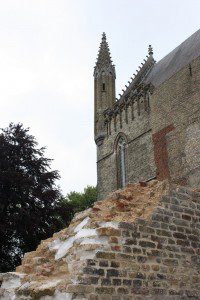 The tour guide had nearly finished his talk.
The tour guide had nearly finished his talk.
He had led a group of Canadian tourists (I was hosting) through a former European wasteland. Just over 90 years ago, the centre of Ypres, Belgium, was little more than rubble and mud. Fighting between invading German armies and Allied forces (including thousands of Canadian troops) defending the Flemish city had levelled everything recognizable. The First World War had left virtually every building in the city core in heaps of broken stone and splintered wood. Then tour guide Raoul Saeson pointed to a disintegrating wall of the former rectory near the reconstructed St. Martin’s Church.
“It’s the only part of Ypres that has been left as it was in 1918,” he said. “Every other part of the city has been restored to the way it was.”
My recent trip through the former battlefields of France and Belgium has opened my eyes to the remarkable recovery that people here have achieved in the wake of the two World Wars of the 20th century.
Earlier during that same day, tour guide Saeson had led us through the city’s former Cloth Hall. There, beginning in the 13th century, makers of the finest linens in Europe had gathered year-round to buy and sell their wares. On Nov. 22, 1914, three months into the Great War, the first shells from attacking German artillery crashed into the hall, eventually reducing the structure – about the size of three St. Lawrence Markets – to rubble.